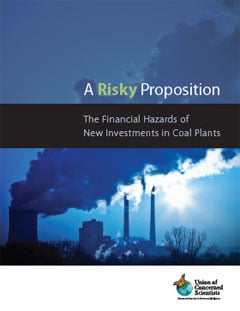Across the United States, the electric power sector is placing new bets on an old technology—coal-fired power plants. Utilities and other electricity producers are poised to invest heavily in retrofitting their old plants or in building new ones.
Each major retrofit or new plant represents an enormous long-term financial commitment to coal power. But as discussed in this report, current economic, technological, and policy trends make such commitments exceedingly risky:
- Demand for coal power is being steadily eroded by competition from energy efficiency and renewable energy, which are benefiting from rising policy support, growing public investment, advancing technologies, and often-falling prices.
- Coal power faces much stronger competition both from new and existing (though underutilized) natural gas plants.
- United States coal prices are rising and could be driven much higher by soaring global demand and shrinking reserves.
- Construction costs for coal plants remain high, and all these risks make the financing of long-term coal investments both harder and costlier.
- Coal plants, new and old, are losing the cost advantages they once had, and lack the operational flexibility that will be increasingly valuable as the power grid evolves to integrate more sources of clean but variable renewable power.
- Coal power faces the financial risks posed by its many environmental impacts. The continuing damages that coal power poses to our air, land, and water—and our health—are a major financial liability that remains unresolved.
- Coal plants emit air pollutants that still kill thousands of people yearly, costing society over $100 billion per year, by one estimate (CATF 2010). These plants are also a leading source of mercury, which threatens children’s brain development;
- Coal plants create vast quantities of toxic ash, which require careful handling in order to prevent leakage;
- Huge cooling-water withdrawals by coal plants strain our increasingly vulnerable water bodies.
- Expected regulations would reduce many of these costly harms, but as several recent financial analyses point out, much of the nation’s coal fleet is already old, inefficient, and ripe for retirement. Rather than retrofit them, it makes greater economic sense to close them.
- Finally, there is the unavoidable financial risk associated with coal’s critical role in destabilizing the global climate. Given the increasingly dire nature of global warming, climate legislation is still widely expected in the years ahead, with inevitable cost implications for coal plants.
Dependence
Long-term investments in coal would be less risky if the nation had no choice but to continue with its current level of coal use, no matter how high the costs. But that is not the case.
Studies by the Union of Concerned Scientists and others show that we could in fact replace most of our coal power using renewable energy, demand reduction, and natural gas within the next 15 to 20 years, with additional reductions in coal power afterward (Keith et al. 2010; Specker 2010; Cleetus, Clemmer, and Friedman 2009).
Risky proposition
When considering long-term investments in coal today, it is helpful to remember an earlier era of power-sector investments that did not end well.
In the 1970s, utilities invested massively in both coal and nuclear plants while ignoring the sweeping changes that were increasing the costs of, and decreasing the demand for, such plants. The result was staggering financial losses around the country as scores of plants were cancelled after years of spending.
We can avoid repeating that costly history by recognizing that changes under way today are making long-term investments in coal power an unacceptably risky proposition.
Unique opportunities
Combined, these trends and developments create risks that no one considering a long-term investment in new or existing coal plants can afford to ignore.
They also create unique opportunities to invest instead in the cleaner technologies that will be in growing demand as we transition toward a more modern, flexible, diversified, and sustainable energy system.
And the overall benefits of transitioning to a cleaner energy system—saving lives, protecting air and water, and helping us avoid severe climate changes while stimulating technological innovation and building new clean-energy industries—would be tremendous.




